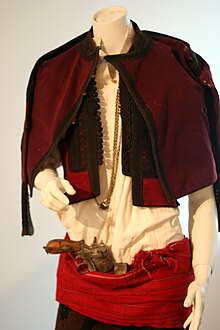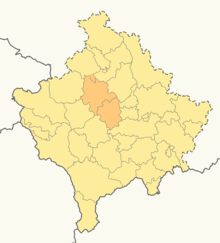Drenica
Drenica ( Albanian also Drenicë ; Serbian - Cyrillic Дреница ) is a region in the center of Kosovo .
Surname
The origin of the name Drenica is not clear; The word root can be derived from both Serbian and Albanian . The Serbian word дрен / dren means " cornel cherry ". In Albanian, dre means " deer ", in Gegic Albanian the specific form is dreni . In both languages, Dren is used as a (predominantly male) first name.
region
Drenica is a hilly area in central Kosovo with a size of about 1200 square kilometers. It is traversed by the Drenica River of the same name, which flows into the Sitnica . The region lies west to northwest of the capital Pristina and mainly includes the municipalities of Drenas and Skënderaj . Its population of 109,389 consists almost entirely of Albanians . Furthermore, other areas of the surrounding communities, especially Istog and Vushtrria , historically belong to the Drenica.
history
In ancient times , the region was located in the middle of the area of the Dardan tribe , which was also inhabited by Celts and Thracians . In the middle of the 1st century the area came under the rule of Rome for several hundred years . Between the 6th and 7th centuries, the area was conquered by Slavic tribes , which brought about the disappearance of Roman culture. From the 7th century the Byzantine emperors ruled the area again until the beginning of the 9th century. Then the region was conquered by the Bulgarian Empire . Between the 11th and 12th centuries, Serbian rule began under the Nemanjid dynasty , and the region became part of the Serbian kingdom. The empire was in the 13th and 14th centuries, especially under the leadership of King Czar Dušan the hegemonic power in Southeast Europe .
Drenica was first mentioned under the rule of the Serbian despot Stefan Lazarević in the already collapsing medieval Serbian Empire in 1413, when the later Serbian despot Đurađ Branković was on the way to the Orthodox Paul monastery on the holy Mount Athos , accompanied by his mother Mara and his brothers Đurđe and Lazar , reached the local village of Dobroševce . Despot Đurađ Branković had the Serbian Orthodox Devič monastery built near the Drenice Forest in memory of his daughter in 1434.

Despot Đurađ Branković is said to have made enormous efforts to save Serbia from the conquest by the Ottomans, could only postpone this, but not prevent it. During the time of the Ottoman occupation, the region was also called Crvena Drenica or Drenica e Kuqe ("Red Drenica") in memory of the bloody conflicts . 1850-1860 Jashar Pascha Cinić conquered the southern part of Drenica, which since then has mostly been known as Drenica e Pashës among the Albanian population . There are around 20 villages in this region. Since then, a distinction has been made between Drenica e Pashës and Crvena Drenica / Drenica e Kuqe .
The inhabitants of this region, mainly Albanians, traditionally showed strong resistance against military occupying powers, first against the Ottomans and later against the Austrians and Serbs during and after the First World War.
Kosovo war
The region around Drenica was considered a stronghold of the Albanian paramilitary organization UÇK . The Jashari family also comes from the region. Adem Jashari was a co-founder of the UÇK. From October 1997 until the beginning of the Serbian offensive in February 1998, Drenica was an area of operations of the KLA and was at times referred to as a "liberated" area. In 1998 there were several violent military clashes between the Yugoslav People's Army and the KLA. After the end of the Kosovo war, international forces ( KFOR and UNMIK ) also took control of the Drenica area.
literature
- A Week of Terror in Drenica - Humanitarian Law Violations in Kosovo ( HRW report)
- HRW report on massacres on Albanian civilians in Drenica region
Individual evidence
- ↑ Martin Bock: Travel Guide Kosovo: Nature and culture between Amselfeld and the Albanian Alps . Trescher Verlag, 2017, ISBN 978-3-89794-738-2 , pp. 169 ( google.de ).
- ↑ Dren. In: behindthename.com. Retrieved September 23, 2016 .
- ^ Human Rights Watch (ed.): Under Orders: War Crimes in Kosovo . 2001, ISBN 978-1-56432-264-7 ( google.de [accessed April 11, 2017]).
- ^ The Independent International Commission of Kosovo: The Kosovo Report Conflict * International Response * Lessons Learned . Oxford University Press, 2000, ISBN 0-19-924308-5 , pp. 67–69 (English, limited preview in Google Book Search).
